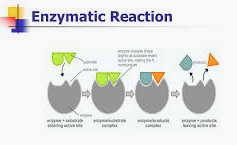ENZYME REACTION Online Test and Answers Pdf Download :-
These are very useful & Most Asked Questions in your certification Exam. Read all Online Mock Test Exam Question Bank for Beginners Freshers & Experienced.
1. The ability of Vibrio fischeri to convert chemical energy directly into radiant energy in bioluminescence is an example of __________ at work.
A. Shelford’s law of tolerance
B. Leibig’s law of the minimum
C. the first law of thermodynamics
D. the third law of thermodynamics
Answer: C
2. The ability of a competitive inhibitor to bind to an active site in an allosterically controlled enzyme is __________ than the ability of a non-competitive inhibitor to bind to an active site in the same allosterically controlled enzyme.
A. greater
B. lesser
C. approximately equal
D. half
Answer: A
3. The ability of FADH to be oxidized is __________ than the ability of FAD to be oxidized.
A. greater
B. lesser
C. approximately equal
D. half
Answer: A
4. An endergonic reaction is one that
A. requires energy in order to proceed
B. releases energy for work
C. gives off much heat
D. looses energy
Answer: A
5. Reduction is the
A. loss of proton
B. gain of electron
C. loss of electron
D. gain of protons
Answer: B
6. If the Keq for an enzymatic reaction is greater than 1, the reaction
A. will be endergonic
B. can not occur without the input of energy
C. both (a) and (b)
D. none of these
Answer: D
7. An exergonic reaction is one that
A. requires energy to proceed
B. releases energy for work
C. gives off much heat
D. looses energy
Answer: B
8. If the free energy change (ΔG) in a reaction is a negative value, it indicates that the
A. reaction releases energy
B. reaction absorbs energy
C. reaction is in negative direction
D. reaction is in positive direction
Answer: A
9. To a living organism, which of the following has the greatest amount of available energy per molecule?
A. ATP
B. ADP
C. AMP
D. H2O
Answer: A
10. Which of the following is the best evidence for the lock and key theory of enzyme action?
A. Compounds similar in structure to the substrate inhibit enzyme activity
B. Enzymes are found in living organisms and speed up certain reactions
C. Enzymes speed up reactions by definite amounts
D. Enzymes determine the direction of a reaction
Answer: A

ENZYME REACTION Objective Type Questions with Answers
11. In the reaction, C6H12O6+ 6O2 → 6CO2 + 6H2O + energy, which component is being oxidized?
A. C6H12O6 B. O2
C. CO2 D. H2O
Answer: A
12. The fact that β-oxidation of fatty acids, occurs in the mitochondria whereas fatty acid synthesis occurs in the cytoplasmic matrix, is an example of regulation of enzymatic activity by the __________ mechanism.
A. compartmentation
B. induction
C. competitive inhibition
D. repression
Answer: D
13. In the reaction, C6H12O6 + 6O2 → 6CO2 + 6H2O + energy, which component is being reduced?
A. O2
B. CO2
C. H2O
D. Energy
Answer: A
14. The affinity of an enzyme for its substrate, when the enzyme has a Km of 0.50 M will be __________ than the affinity of an enzyme for its substrate when the enzyme has a Km of 0.05 M.
A. greater
B. lesser
C. approximately equal
D. half
Answer: B
15. Anthranilate synthase, the first enzyme of tryptophan biosynthesis after the branch point shows feedback inhibition and repression due to
A. L-tryptophan
B. D-L-tryptophan hydantoin
C. L-serine
D. pyruvate
Answer: A
16. A substrate binds to its enzyme at a location called the __________ site.
A. coenzyme
B. substrate
C. active
D. polypeptide
Answer: C
17. Hydrogen and oxygen release enormous amounts of energy when they react. Yet, hydrogen and oxygen can be mixed together in a balloon and nothing will happen. Why?
A. Competitive inhibitors are blocking the reaction from occurring in the active site
B. There must be contaminating elements in the balloon that prohibit the reaction from occurring
C. The energy of activation to form the transition-state complex is too high to allow the reaction to occur without assistance
D. all of the above
Answer: A
18. Adenosine triphosphate is a type of
A. fatty acid
B. amino acid
C. nucleotide
D. steroid
Answer: C
19. An enzyme that is always produced, regardless of the presence of substrates or the end products, is called
A. a constitutive enzyme
B. an isoenzyme
C. a repressible enzyme
D. an allosteric enzyme
Answer: A
20. About 7.3 kcal/mole are released when
A. glucose is converted to CO2 and H2O
B. NAD+ is reduced to NADH
C. ATP hydrolysis is coupled to sucrose synthesis
D. the terminal phosphate bond of ATP is broken by hydrolysis
Answer: A
21. The ability of CTP to bind to aspartate carbamoyltransferase and shut down the synthesis of more CTP is an example of
A. enzyme induction
B. enzyme repression
C. feedback inhibition of enzyme activity
D. none of these
Answer: C
22. Oxidation is the
A. loss of proton
B. gain of electron
C. loss of electron
D. gain of protons
Answer: C
23. Denaturation of an enzyme refers to the
A. improper arrangement of the enzyme in a metabolic pathway
B. loss of the enzymes proper shape
C. formation of the enzymes proper shape
D. formation of a new isozyme for that enzyme
Answer: B
![MCQs [2024]](https://engineeringinterviewquestions.com/wp-content/uploads/2021/02/Interview-Questions-2.png)